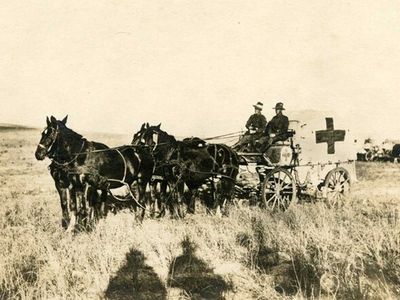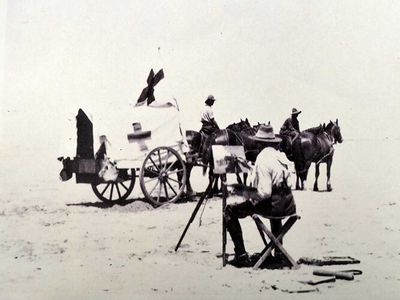“Major Avery, among many other Old Boys, holds a special place on the TGS Old Boys’ Wall of Achievement for his role in inventing the “Rapid Transit Ambulance” that was a key part of the Australian Light Horse Brigade.”

On ANZAC Day, we come together to reflect on the importance of service and sacrifice.
Toowoomba Grammar School would like to acknowledge our admiration for the loyalty, service and bravery exhibited by TGS Old Boys who so valiantly served. We are all the beneficiaries of their sacrifice, and their selfless actions continue to inspire a spirit of service amongst our current students.
Today we focus on the contribution of one TGS Old Boy who made a significant contribution to World War I. Here is some of the incredible story of Major Avery, DSO and if you visit the School Museum and Archives you can see a display in his honour.
Much of this history has been captured through countless hours of dedication and devotion by current TGS museum volunteer and former TGS staff member, Mrs Ann Hallam who managed the School’s Cadet Unit from 2006-2019.
Major Avery DSO, inventor of the WWI “Rapid Transit Galloping Ambulance”
Distinguished TGS Old Boy, Leonard Grimes (1880-1885) was born in Queensland in 1869 and died in 1953. Grimes attended the School in the days of Sir Harry Chauvel and Sir Littleton Groom and while at TGS was known as Leonard Avery Grimes.
After his School days he went on to Wadham College, Oxford, where he graduated with a medicine degree. He later changed his name to Conrad Avery and after some years as a hospital physician and surgeon, Avery enlisted with the British Army and joined the Suffolk Imperial Yeomanry. He was later promoted to Major and joined the Royal Army Medical Corps. During World War I he was enlisted with the Royal Westminster Dragoons and served in Palestine, Egypt and Syria.
Major Avery, among many other Old Boys, holds a special place on the TGS Old Boys’ Wall of Achievement for his role in inventing the “Rapid Transit Ambulance” that was a key part of the Australian Light Horse Brigade.
Light Horse Field Ambulance
The Light Horse units were mounted infantry with efficient mobile medical support to the wounded and sick soldiers of an Australian Light Horse Brigade. The Field Ambulance ensured the removal of the wounded from the front line to the advanced dressing station where there were surgical and resting tents.
These sand carts had two wheels with tyres that were wide enough to stop the cart digging into soft sand and could carry two or three stretchers. In heavy sand four horses were necessary to pull the cart, and the cart had to be steered by a rider on one of the lead horses.

Australian Light Horseman
The 2nd Light Horse Field Ambulance was formed in Brisbane with much of the unit coming from Queensland.
More than 15 TGS Old Boys enlisted with the Second Light Horse Brigade, two of whom died at Gallipoli: Major Dugald Maxwell Lockwood Graham and Trooper Gordon Holmes Robertson.
During the World War I, George W. Lambert (1873-1930) served Australia as an Official War Artist attached to the ANZAC Mounted Division. He spent two terms in service, the first with the Light Horse in Palestine, and the second in Gallipoli and Egypt before his military contract discharge.
As a result of Lambert’s service during World War I, he was offered a variety of commissions to paint scenes from significant war time events, including an activity of the 2nd Australian Light Horse Field Ambulance, Walk (An Incident at Romani).
The Battle of Romani was the last ground attack on the Suez Canal at the beginning of the Sinai and Palestine Campaign. The battle was fought from 3 to 5 August 1916 near the Egyptian town of Romani.
The completed painting was to be given to the Queensland (National) Art Gallery by the Light Horse in memory of their fallen comrades.
The Rapid Transit Ambulance
Major Avery describes his vision for a new galloping ambulance, known as “The Rapid Transit Ambulance”.
This ambulance was designed with a view to filling the want of stretcher bearers with mounted troops. The endeavor has been to construct a light strong carriage easily adjustable to any mounted horse and capable of keeping up with cavalry through any sort of country. As will be seen from the accompanying illustration, the ambulance is a two-wheeled contrivance.
The body consists of a platform fixed to a crank axle by long springs between 46-in. wheels. This platform is 2 ft. 3 in. from the ground and is arranged to carry an ordinary service stretcher. The forepart consists of a pair of short shafts which are attached to the body by an arrangement of springs adapted to prevent the side-to-side motion caused by the action of the horse. The shafts reach as far forward as the saddle flaps, where they are held in position by a girth strap, breastplate, and belly-band.
The body is covered by a canvas hood. The weight is about 3 cwt. Length overall, 12 ft. Track, 4ft. 1 in. Surgical dressings, splints, water-bottle, &c., are carried. It is quite easy for the driver, having placed a wounded or helpless man in a stretcher, to transfer him from the ground to the platform of the carriage single-handed.
This ambulance has been on duty with the Suffolk, Sussex, Surrey and Middlesex Imperial Yeomanry during their respective training, and with the Wiltshire Yeomanry through the recent maneuvers. It is a very comfortable conveyance and has proved capable of negotiating with almost any country.
Walk (An Incident at Romani)
The incident to which Lambert’s painting refers occurred during the Battle of Romani on 4 August 1916. The 2nd Light Horse Field Ambulance had deployed two sand-carts to an exposed part of the line to retrieve some seriously wounded men. Upon its return journey the Field Ambulance envoy came under Turkish fire and its panicked horses started to bolt.
Tragedy was averted when the corporal signaled ‘Walk’ and galloped to the front of the party to steady the teams. After the horses had been calmed and resumed their pace, the enemy apparently recognised the Ambulance’s mission and averted their fire. As a result of their bravery and composure during the incident the corporal and drivers were awarded Military Medals.

To enable Lambert to make sketches of the event that was already three years in the past, it was re-enacted at Kantara, Egypt in 1919. Photographs were taken of Lambert at work sketching this re-enactment. The completed painting portrays the moment when the corporal signals ‘Walk’ whilst rushing to the front of the group to steady the bolting teams.
Remembrance Day
Remembrance Day marks the anniversary of the Armistice which ended the First World War, signed at 11:00am on 11 November 1918. We still remember those who have given their lives in conflict before and since, by taking a minute to stop, be silent and remember the war that was to end all wars.
Latest Blog
Why Study Drama?
As an educator with over 30 years’ experience in the Arts, I specialise in the analytical, creative and practical spheres that quantify and qualify success in drama. I have been a Drama teacher and Arts Project Officer in the Independent, Catholic, state, and private sectors in primary and secondary, single sex and co-educational environments. This longevity of knowledge, gained through firsthand experience, affirms that students who study drama through until at least Year 10 acquire…
Drive and Determination
Jeremy Peacock is ranked third in the world in the PTS4 Para category and his sights are set on selection for the 2024 Paralympic Games in Paris. During Jeremy’s time at TGS he represented the School in numerous endeavours but was particularly known for his contributions to the Arts, particularly Music. On the sports field, Jeremy represented TGS in GPS Athletics, Cross Country, Cricket and Football. After returning from a gap year in the UK teaching music at Port Regis School, Dorset, Jeremy…
That Life-Changing Moment
His teacher, Mrs Rosemary Bishop saw his potential. She believed this young indigenous boy from Murgon had something special to offer the world and she fought to put him on the path to greatness. Mrs Bishop contacted the then Headmaster of Toowoomba Grammar School, Mr William Dent and asked if Waverley could be accepted into Toowoomba Grammar School on a scholarship. Mr Dent agreed and so changed the course of Waverley’s life. “I don’t like to think about where I would be now if that hadn’t…
Senioritis - The way we think affects the way we feel and behave
As high school students approach their final year, they may experience a phenomenon known as "Senioritis". As described by educators, Senioritis is a decrease in motivation and productivity, often accompanied by procrastination, complacency, and negative risk-taking behaviours. While not a medical term, Senioritis is a widely recognized term used to describe a common set of observed behaviours. As Jessica Lahey notes, "Senioritis is a real phenomenon. It can be defined as a decline in…
A Space for Learning
A core pillar of the Toowoomba Grammar School Strategic Plan is to provide an inspiring and broad curriculum for all boys, adopting technology and innovative pedagogy to transform learning outcomes. Over the last couple of years, the COVID-19 pandemic has prompted teachers to explore new frontiers of pedagogy, adapting to the difficult circumstances by launching interactive software, digitising trusty, tried and true resources, recording our lessons, flipping our classrooms, and cultivating an…
When it comes to Music, Variety is the Spice of Life
In the Queensland Curriculum, the content of the music syllabus includes the study of the people, places and cultures involved in musical creation and performance. As our country becomes increasingly diverse, it is important for students in every school setting to study a wide variety of musical styles, cultures and genres. The Toowoomba Grammar School Music program of 2022 embraces this holistic approach to the study of music, encouraging teachers and students to explore a variety of musical…
A Trailblazer for Multicultural Australia
Wellington Lee has been described as a trailblazer for multicultural Australia. He was born in 1925 and attended TGS from 1940-42 before serving with the RAAF during WWII from 1943-46 and the Active Reserve of Officers from 1953-83. Mr Lee was a remarkable man of good character who lived in an exciting time of growth and change during Australia’s, and particularly Victoria’s history; the early days in Melbourne when 10% of their population was a thriving Asian community. It was also a…
REACH - Character Development in the Junior School
Being a kind person is fundamental to the growth of a successful person. Adults in our young men’s lives have a responsibility to model and teach the importance of respect, accepting and acknowledging our need to contribute to society in a positive and meaningful way. In 2016, the Junior School staff felt there was a need to create a program that allowed us to develop the character of the boys in the Junior School. Tailoring a program to meet our boys’ needs rather than a generic one allows…
The Grass is Always Greener
It’s time we put this age-old rumour to rest once and for all… The Toowoomba Grammar School ovals are not painted, dyed or manufactured grass; rather, the glorious green that greets passers-by as they drive into the Garden City comes from the sheer hard work and dedication of our TGS grounds team, led by Danny Beresford. Danny has exceptional pride for his grounds and a strong family connection to TGS. He is an Old Boy (2002-04) who played for the 1st XV in 2004 and was in the Track and Field…